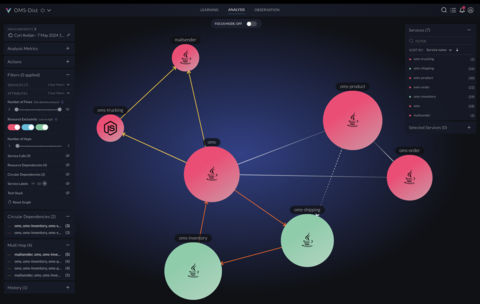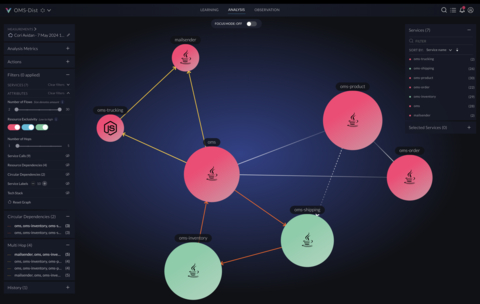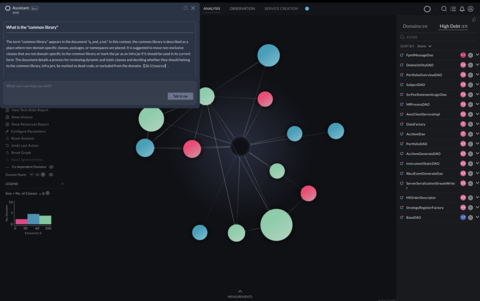MENLO PARK, Calif.--(BUSINESS WIRE)--vFunction, the pioneer of AI-driven architectural observability (AO), today announced new AI-guided advancements designed to proactively navigate the intricacies of distributed architectures as enterprises scale and face technical debt in microservices environments. With vFunction architectural observability for distributed applications, software architects and engineers can now monitor architectural drift within their distributed applications in real time, preventing the accumulation of complexity and compounding technical debt caused by intricate microservice interactions. Whether moving from monoliths to distributed architectures or further decomposing existing microservices, vFunction supports the full architectural spectrum to merge or modularize domains and services. This enables teams to analyze the impact of architectural decisions as they arise, no matter what type of architecture applications are built on. Through the integration of a GenAI-based assistant, vFunction streamlines the process of re-architecting and refactoring by providing guided recommendations and automating tasks to restore engineering velocity, increase resiliency and scalability, and ultimately drive the continuous improvement of application architecture through architectural observability.
“As applications grow increasingly distributed and complex, it’s challenging for enterprises to maintain architectural integrity and keep complexity in check. Today’s point solutions provide fragmented visibility, leaving organizations blind to emerging technical debt and architectural drift,” said Amir Rapson, CTO and co-founder of vFunction.
Rapson continued, “With these latest vFunction advancements, enterprises can manage technical debt and holistically understand and visualize the dependencies between logical domains within any application architecture while receiving guidance to make modernization tasks like refactoring and re-architecting considerably simpler. Architectural observability is now accessible to organizations who are on their journey to the right software architecture, be it cloud-ready modular monoliths to distributed cloud-native microservices-based applications.”
“Addressing architectural debt isn't just a technical cleanup, it's a strategic imperative,” said Hansa Iyengar, senior principal analyst at Omdia. “Modern businesses must untangle the complex legacy webs they operate within to not only survive but thrive in a digital-first future. Every delay in rectifying architectural debt compounds the risk of becoming irrelevant in an increasingly fast-paced market. vFunction's architectural observability platform provides a practical tool to proactively manage architectural drift and technical debt and enhance resilience, scalability, and speed-to-transformation.”
vFunction Architectural Observability Platform Delivers Visibility and Control Over Distributed Architecture Sprawl
Enterprises have long struggled with the lack of visibility into the architecture driving critical applications, leaving software architects and engineering teams grappling with complex interdependencies and technical debt. For organizations with distributed microservice architectures, this challenge is exponentially amplified as architectural complexity bleeds into a labyrinth of service interactions and data flows. A study commissioned by vFunction and released today found nearly forty percent of enterprises (39%) cited the lack of visibility into architecture as a top challenge over the last five years for software architects and engineers. The lack of visibility makes it hard to know which microservices talk to each other.
With new architectural observability support for distributed applications, vFunction enables enterprises to remediate architectural technical debt, a pervasive form of technical debt holding back engineering excellence, application resiliency, and scalability. vFunction provides:
- Automated, AI-driven analysis, which proactively identifies areas where microservices should be decomposed further or consolidated based on evolving business needs and outlines actionable ways for organizations to reduce technical debt in each application. For example, these areas can be circular calls between services, traces that have too many hops between services, services that interact with the same services or the same database tables, and more.
- Continuous observation, including scheduled support and triggered scans for architectural drift, which ensures adherence to intended boundaries and dependency rules over time, and fosters strong architectural health.
- Extensibility and compliance to make it simple for organizations to manage their own unique architectural needs, such as creating custom rules and alerts. For example, a company may set up an alert to ensure its hundreds of microservices adhere to a specific architectural security policy.
- Integration with OpenTelemetry, adding support for a wider set of technology stacks, including Python, Go and Node.js. This makes it possible for vFunction to address a wide market and more types of applications, and empower more practitioners to tackle architectural concerns.
GenAI-enabled vFunction Assistant Streamlines Re-architecting and Refactoring Tasks, Accelerating Application Modernization
Re-architecting and refactoring tasks can be overwhelming, especially when unpacking complex code. The new vFunction Assistant, leveraging ChatGPT-4, serves as a guide for development teams to detect and remediate a broad range of architectural issues, while boosting productivity through intelligent task automation. It provides prescriptive guidance, breaking down complex refactoring objectives into consumable, bite-sized steps, to steer teams toward more optimized, scalable, and resilient architectures.
"The vFunction Assistant simplifies an otherwise complex process by focusing engineering efforts on prioritized, high-impact changes aligned with target architecture goals,” added Rapson. “With a GenAI Assistant, developers can accelerate their transition to scalable, cloud-native architectures.”
Resources
- Learn more about vFunction’s vision for AI-driven architectural observability.
- Read more about vFunction’s new features for distributed applications.
- Watch how vFunction tackles architectural technical debt.
About vFunction
vFunction, the pioneer of AI-driven architectural observability, delivers a platform that increases application resiliency, scalability, and engineering velocity by continuously identifying and recommending ways to reduce technical debt and complexity in applications. Global system integrators and top cloud providers partner with vFunction to assist leading companies like Intesa Sanpaolo and Trend Micro in discovering their architecture and transforming applications to innovate faster and change their business trajectory. vFunction is headquartered in Menlo Park, CA, with offices in Israel, London, and Austin, TX. To learn more, visit www.vfunction.com.





